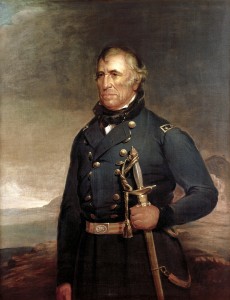
Heroes in American history come in all shapes and sizes. Some are strong, resilient and yet gentle, like Martin Luther King Jr and George Washington. Others are loud, fiery and full of passion, like Patrick Henry and Theodore Roosevelt. But there is no doubt that there is a certain mold of Americans who are just “rough and ready”. The rugged American hero is a quintessential part of our history and it is only fitting that some rough and ready fighters ascended to the nation’s highest office: the Presidency. One of these heroes who proved himself rough and ready both on the battlefield and in the White House was Zachary Taylor.
Zachary Taylor was born in 1784 (one year after the United States’ independence was recognized by Great Britain) in northern Virginia. Taylor was descended from the Pilgrims and was somewhat-distantly related to James Madison. The Taylors were an important and prominent planting family in northern Virginia but they left that state while Zachary was still a child. The Taylors settled in Kentucky, near Louisville.
Zachary joined the army in 1808 and so began a long, successful and illustrious military career. He led troops in the Indiana territory during the War of 1812. He was responsible for the defense of Fort Harrison in 1812 and other battles in the Old Northwest. In 1828, Taylor went north to Minnesota to command Fort Snelling. He was involved in commanding forts in the northern Mississippi river area until the spring of 1832 when the Black Hawk War broke out in Wisconsin and Illinois and Taylor led troops against the Native Americans under Chief Black Hawk. It was during the Second Seminole War in 1837, however, that Taylor received national recognition for his military leadership. He defeated the Seminole Native Americans at Lake Okeechobee, Florida. This battle gave him nationwide attention and gave rise to his nickname “Old Rough and Ready”.
Taylor spent his most famous fighting years during the Mexican-American War. He was in Texas with his troops when war broke out and quickly defeated the Mexicans at Palo Alto and Resaca de la Palma. He besieged Monterrey, Mexico and took it. However, his most famous and successful battle was the fight against Antonio de Santa Anna at Buena Vista in 1847. It was here that Taylor, heavily outnumbered and facing the general who had taken the Alamo in 1836, defeated the attacking Mexican army and forced a Mexican retreat. Upon his return to Louisiana in late 1847, he received a hero’s welcome.
This wartime popularity propelled Taylor into the Presidency in 1848, accompanied by Vice-President Millard Fillmore. Taylor believed in a weak executive and strong legislature. Immediately in 1849, Taylor was hit with a crisis of Southern states threatening secession over slavery. Taylor was a slave-holder but he valued the Union and therefore was against the secession of the Southern states. He was in office during the dealings of the Compromise of 1850 which brought the crisis to a temporary resolution.
In 1850, Taylor died in office from a digestive illness. Millard Fillmore succeeded him in the office of President. Although his Presidency had been brief, Taylor’s military legacy was a great one. He was remembered as a rugged American fighting hero who would rather wear his straw hat into battle than his official uniform. His “rough and ready” manner was an essential persona of the American military man. He stood for unity and liberty while President and worked tirelessly for the people who had put him into office.
